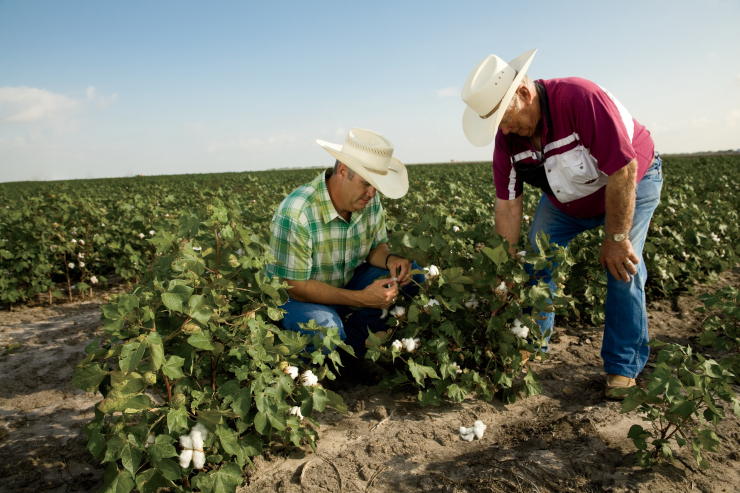Home > Texas > Texas Crops & Livestock > From Field to Fiber: Cotton’s Journey
From Field to Fiber: Cotton’s Journey
In partnership with: Texas Department of Agriculture

Follow the journey of the Texas cotton crop:
- Soil Preparation – Before planting can begin, farmers test the soil to determine what additional nutrients are needed. Different areas in the field are tested to determine the necessary amount to fertilize and with the ultimate goal of adding only what’s necessary to grow a good crop. Cotton farmers, like all crop producers, utilize best management practices when making soil preparation decisions.
- Planting – Planting can begin as early as February in South Texas and continue into late May or early June in the High Plains. Before planting can begin, the seedbed is prepared, according to the planting method the farmer will use. Some farmers till the soil to plow up any weeds that would compete with the cotton plant for nutrients and to form ridges or rows. May other farmers utilize no-till or reduced-tillage practices, which minimizes the overall impact on the field. The seeds are then planted with mechanical planters that can cover as many as 10 to 24 rows at a time, and it takes about 5 to 10 days for the seedlings to emerge.
- Irrigation and Water Management – Water is one of the most important factors necessary to grow a good cotton crop. Physiologically, a cotton plant can endure periods of drought, but it responds favorably to optimum water, which results in a better crop. Many farmers utilize irrigation systems to supplement the water needs of their cotton crop, and in 2012, some 2.2 million cotton acres in Texas were irrigated, according to the U.S. Department of Agriculture. These technologically advanced systems allow the farmer to apply specific water quantities to the fields based on need. Other farmers rely on Mother Nature to provide the necessary rainfall to produce a good cotton crop.
- Pest Management – Cotton is highly susceptible to aphid, mite, bollworms, boll weevils, thrips, white flies and other pests. Identifying problems requires multiple checks of the fields throughout the growing season, which is often done by crop consultants who spend up to 30 hours a week checking cotton fields for various farmers. Many Texas farmers have an integrated pest management system that uses both predator insects and insecticides.
- Harvesting – The cotton boll is the green pod left behind when the cotton flowers mature and fall off. Inside the boll, fibers grow and push out. When enough bolls have turned brown and opened naturally, a defoliant can be applied by air or ground application to speed up the maturation process. This ultimately helps more bolls open and the leaves fall off. Farmers use mechanized cotton pickers to pull the fiber from the plant; then the cotton is usually packed into modules, or bale-like units, before it is delivered to the gin.
- Ginning – At the gin, the modules are broken down, and the cotton fiber is separated from the seed. The fiber is now referred to as lint and is packed into bales. A standard bale of cotton fiber is 55 inches tall, 28 inches wide and 21 inches thick, weighing approximately 500 pounds. This is enough to make 325 pairs of denim jeans. The lint is shipped to textile mills or exported, while the seed is transported to cottonseed oil mills or used for livestock feed.
- Processing – The bale is transported to a textile mill for processing. The fibers are mechanically carded, or pulled in the opposite direction, to ensure they are parallel. Combing machines remove impurities in the fiber before it’s pulled thinner and wound onto bobbins that are ready to be spun into yard. The yarn can be used for knitting or weaving into fabric to make garments, furniture coverings and more.



